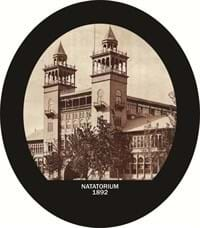 Brian Iverson
Brian Iverson
Loving Husband and Father
We miss you - Sheila, Elizabeth and Iver
After the discovery of geothermal hot water at Kelly Hot Springs, near the Idaho State Penitentiary, C.W. Moore founded the Boise Artesian Hot & Cold Water Company to develop the resource. He asked John C. Paulson to design a hot-water bathing resort.
The Boise Natatorium—the Nat—was opened in May 1892 as a destination recreation center at the eastern end of a trolley line that would run on Warm Springs Avenue from downtown. The Moorish Revival style of the building easily communicated that the activities inside would be "something completely different" for the busy, hardworking citizens of Boise.
The attractions included a 125-foot-long swimming pool, geothermally heated. An artificial waterfall fell over a 40-foot lava rock diving platform at one end. A patron also could choose to plunge into the pool from a copper slide two stories high. Wooden truss arches, 80 feet in diameter, enclosed the interior, and a mezzanine ran around the pool. The resort offered diversions for the whole family: dining room, clubrooms, saloon, gymnasium, baths, dance floors, card rooms and a tea room.
Moore, who had built his own elegant home on Warm Springs in 1891, hoped to persuade the public of the reliability of geothermal water for home heating. He succeeded wonderfully. Other affluent Boiseans soon built residences on the Avenue, purchased geothermal heating, and traveled on the trolley line that soon ran by their front doors.
Eventually, the moisture in the Nat caused its wooden beams to rot. During a 1934 windstorm, one such beam collapsed. It caused no injuries, but it meant the end of the Nat, and the geothermal water was cut off. Boise City opened the pool as an outdoor swimming spot soon thereafter, and it remains today next to Adams Elementary School, alongside a large waterslide, the Hydrotube.
Read more about the Boise Natatorium.